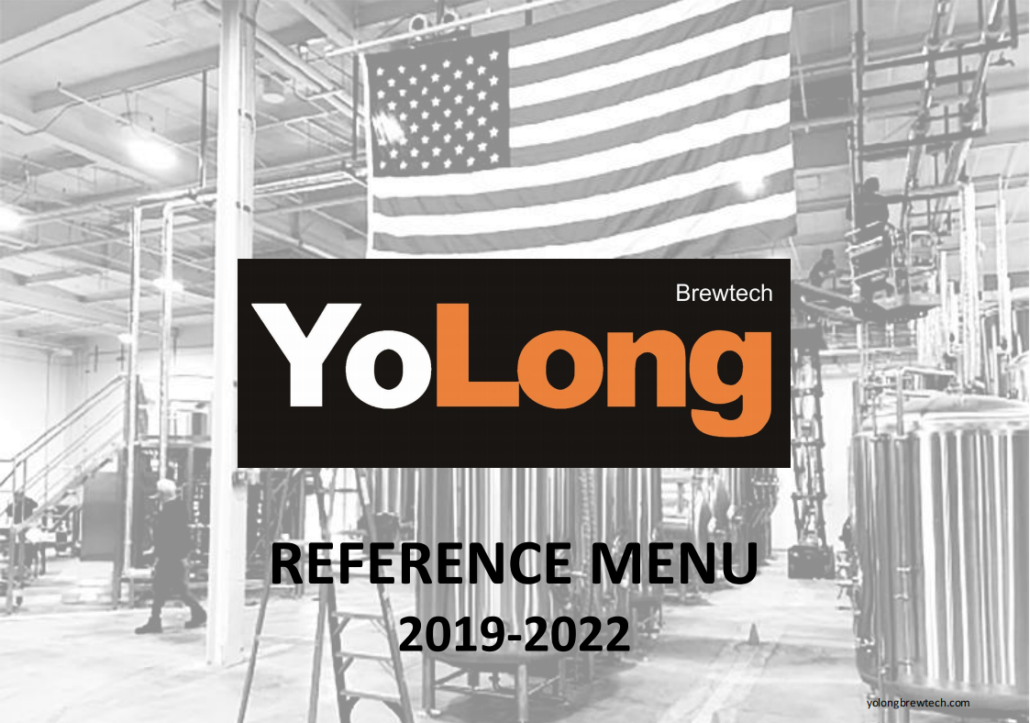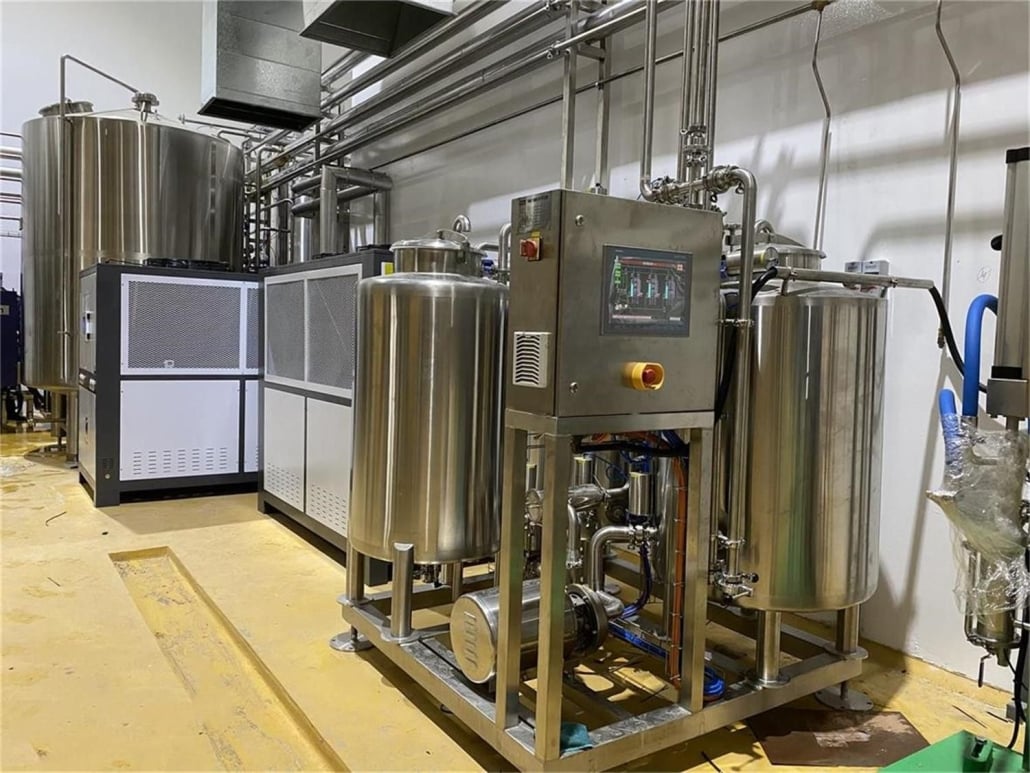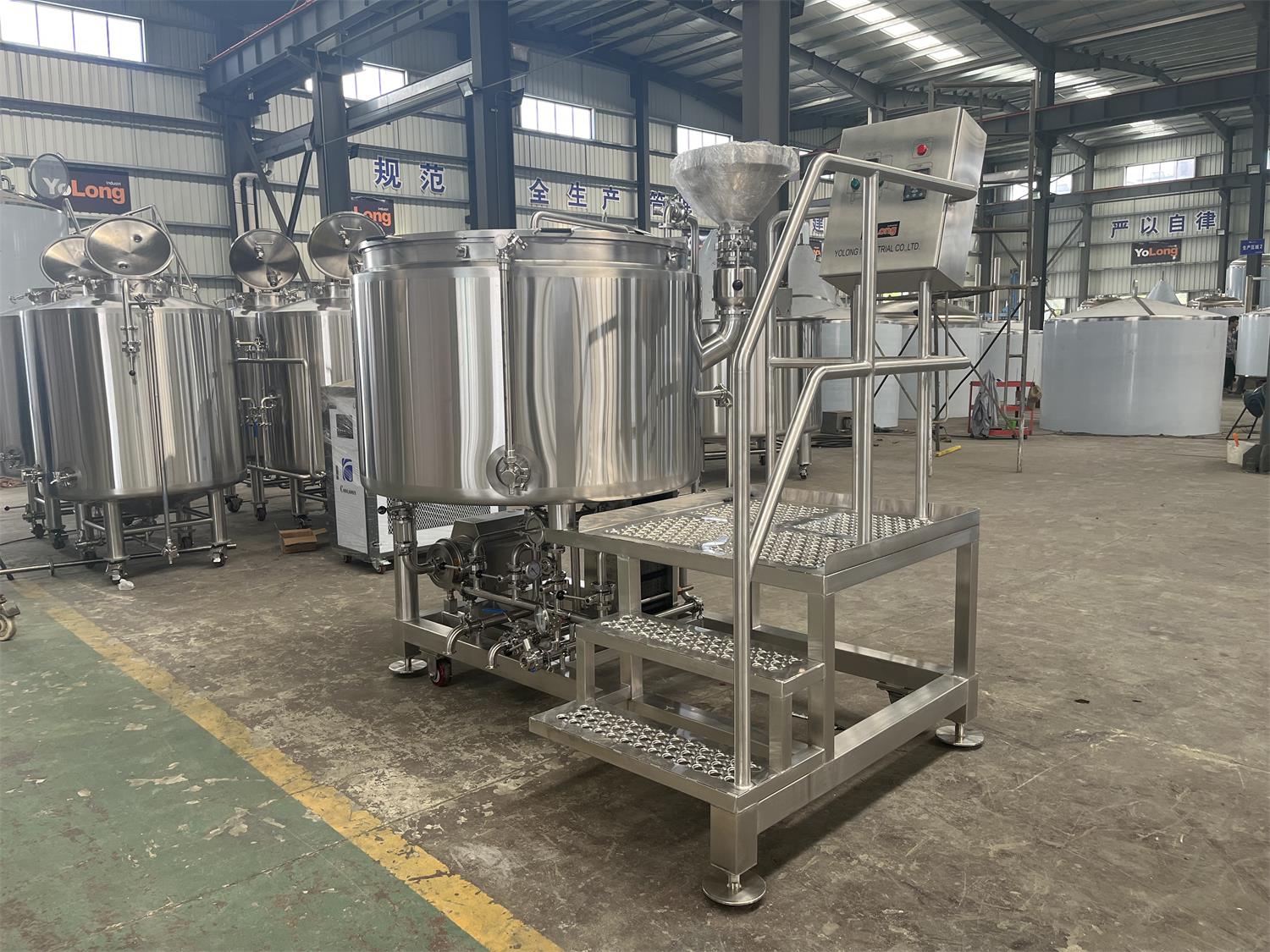Commercial Fermentation Tank
In the world of large-scale production for industries like beer brewing, wine making, and biotech, commercial fermentation tanks play an essential role. These tanks are central to transforming raw materials through the fermentation process into desired products such as alcoholic beverages, biofuels, and pharmaceuticals. This article dives deep into commercial fermentation tanks, offering a comprehensive overview, equipment guide, detailed process explanations, and a breakdown of the best options available on the market.
Overview of Commercial Fermentation Tanks
Fermentation tanks are specialized containers designed to facilitate fermentation. In commercial settings, these tanks allow for precise control over temperature, pressure, and oxygen levels, making them essential for producing consistent, high-quality products at scale. The tanks are used in industries ranging from brewing to bioengineering, where controlled fermentation is necessary to yield the desired product.
Key Features:
- Material: Typically stainless steel to ensure hygiene and durability.
- Capacity: Varies depending on the scale of production, from small craft operations to large industrial setups.
- Functionality: Control over environmental conditions such as temperature, pressure, and oxygen to optimize fermentation efficiency.
- Customization: Tanks can be customized based on the type of fermentation—anaerobic or aerobic, and product type (e.g., beer vs. biofuels).
Now, let’s break down the equipment, processes, and tips for selecting the right commercial fermentation tank.

Commercial Fermentation Tank Equipment Guide
When choosing a fermentation tank for your commercial operations, several factors come into play, including size, functionality, and specific industry requirements. Here’s an equipment guide detailing the various aspects.
Types of Commercial Fermentation Tanks
| Type of Tank | Description | Applications | Advantages | Disadvantages |
|---|---|---|---|---|
| Open Fermentation Tanks | These tanks have no lid, allowing exposure to the environment. | Traditional beer brewing, some wine making | Simple design, easy to clean | Higher risk of contamination, limited control over conditions |
| Closed Fermentation Tanks | Sealed tanks with controlled pressure and oxygen levels. | Widely used in commercial brewing, pharmaceutical production, bioengineering | Precise control over fermentation conditions, better sanitation | More complex maintenance, higher initial cost |
| Jacketed Fermentation Tanks | Tanks with an outer layer for circulating coolant or heating fluid to control temperature. | Used in processes where temperature regulation is critical, such as beer brewing, yeast production, biotech | High level of temperature control, suited for large operations | More expensive, requires more energy to operate |
| Conical Fermenters | Tanks with a cone-shaped bottom for easy sediment removal. | Beer and wine fermentation, yeast harvesting | Easier to remove trub, improved cleanliness | Limited use outside of beverage production |
| Aerobic Fermentation Tanks | Designed for processes that require oxygen, often featuring agitation and aeration systems. | Bioengineering, biopharmaceuticals, food production | Supports aerobic organisms, enhanced mixing capabilities | Energy-intensive, requires complex setup |
Brewing Process Using Commercial Fermentation Tanks
Commercial fermentation tanks, particularly in beer brewing, are the heart of the production process. Here’s a detailed look into the stages of fermentation in a typical brewing system, focusing on how the tank plays a role at each step:
- Preparation: After the wort (a sugary solution) is boiled and cooled, it is transferred into the fermentation tank. For commercial setups, this usually involves a large stainless steel tank with temperature controls.
- Primary Fermentation: Once the yeast is added to the wort in the fermentation tank, primary fermentation begins. The yeast consumes the sugars in the wort, producing alcohol and carbon dioxide. Tanks with temperature control (like jacketed tanks) help ensure the yeast remains active and produces the right flavors.
- Secondary Fermentation: Some brewers opt for a secondary fermentation process, moving the beer into another tank where additional conditioning happens. Here, jacketed tanks or conical fermenters come into play, helping to achieve precise control over temperature and clarity.
- Maturation: During maturation, the beer continues to develop its flavor profile, often in the same tank or a maturation-specific tank. In commercial fermentation tanks, this process can be adjusted for carbonation and alcohol content.
Fermentation Tank Capacities, Space Requirements, and Customization Options
| Capacity (Liters) | Typical Space Required | Design Features | Customization Options |
|---|---|---|---|
| 100-500 liters | Small footprint, ideal for craft breweries and labs. | Simple construction, open or closed fermentation possible. | Custom cooling jackets, fittings for small-scale production. |
| 500-1000 liters | Medium-sized, suitable for growing breweries and pilot production plants. | Often features temperature control, conical designs, or jacketed tanks. | Aeration systems, pressure control, automated monitoring features. |
| 1000-5000 liters | Requires dedicated production space, typically for commercial brewing. | Often comes with CIP (Clean-In-Place) systems, pressure-resistant. | Multiple compartments, automated valves, customizable fittings. |
| 5000-10000 liters | Large production facilities, substantial floor space needed. | Full automation, temperature-controlled, advanced designs. | Customizable fittings, aeration systems, high-precision temperature control. |
| 10,000 liters and above | Large-scale industrial production, specialized facility requirements. | Advanced automation, CIP, SIP (Sterilization-In-Place), precise controls. | Fully customized features based on production needs, cooling systems, multiple inlets/outlets. |
Suppliers and Price Ranges for Commercial Fermentation Tanks
Choosing the right supplier can significantly impact your fermentation operation, both in terms of cost and performance. Here’s a look at some common suppliers and the price range for different types of fermentation tanks.
| Supplier Name | Price Range (USD) | Main Products | Special Features |
|---|---|---|---|
| Ss Brewtech | $1,500 – $10,000 | Small and medium-sized conical fermenters, jacketed tanks for brewers. | Strong reputation for craft brewing equipment, focus on temperature control. |
| JV Northwest | $5,000 – $50,000 | Industrial-sized tanks, particularly for breweries. | Customizable sizes, advanced control systems, durable materials. |
| Cedarstone Industry | $3,000 – $30,000 | Specializes in biopharmaceutical fermentation tanks. | Aeration systems, custom pressure control features. |
| Speidel | $2,000 – $20,000 | Wide range of fermentation equipment, from small-scale to large commercial tanks. | Focus on ease of use, durability, and flexibility. |
| Ziemann Holvrieka | $10,000 – $100,000+ | Advanced stainless steel fermenters for breweries and other industries. | High-tech fermentation tanks with advanced automation. |
How to Operate a Commercial Fermentation Tank
Operating a commercial fermentation tank isn’t as complex as it may seem once you break it down into a few essential steps. Most systems are designed for ease of use, but here’s a general guide:
- Preparation and Cleaning: Before starting the fermentation process, ensure the tank is properly cleaned using a CIP (Clean-In-Place) system. Sterility is crucial to prevent contamination.
- Temperature Control: Modern commercial fermentation tanks come with built-in temperature controls. Use these systems to maintain the optimal temperature for the yeast or bacteria you’re using.
- Pressure and Aeration Management: For processes requiring oxygen (aerobic fermentation), tanks may have built-in aeration systems. In contrast, for anaerobic processes (such as beer brewing), pressure management systems keep unwanted oxygen out.
- Monitoring and Adjustments: Throughout the fermentation process, monitor the pH, temperature, and pressure using the tank’s integrated gauges. Many tanks now come with automated systems that provide real-time data, making the process smoother.
Installation, Operation, and Maintenance of Fermentation Tanks
| Installation Process | Operation Guidelines | Maintenance Tips |
|---|---|---|
| Install tanks on a solid foundation with proper drainage. | Follow manufacturer guidelines for fermentation temperatures. | Regularly clean using the tank’s CIP system to maintain hygiene. |
| Ensure proximity to utilities like power, water, and cooling. | Use integrated controls to monitor pressure, pH, and temperature. | Inspect for any leaks or damage to the tank or its accessories. |
| Tanks should be installed in well-ventilated areas for safety. | Adjust settings for specific fermentation types (aerobic/anaerobic). | Schedule annual maintenance checks to prolong equipment lifespan. |
How to Choose the Right Supplier for Commercial Fermentation Tanks
Selecting the right supplier for your fermentation tank depends on several factors:
| Consideration | Details |
|---|---|
| Reputation | Research the supplier’s reputation through reviews and industry feedback. |
| Customization Options | Make sure the supplier offers customization options to meet your specific fermentation needs. |
| Warranty and Support | Check for the warranty and after-sales service, including the availability of replacement parts |
| Price vs. Quality | Compare price points while considering the quality of materials and features included in the tank. |
| Lead Time | Ensure the supplier can deliver within your desired timeframe, especially if you’re on a tight schedule. |
Comparing Pros and Cons of Fermentation Tank Options
| Fermentation Tank Type | Pros | Cons |
|---|---|---|
| Conical Fermenters | Easier sediment removal, suitable for breweries. | Limited to certain types of fermentation. |
| Jacketed Tanks | Precise temperature control, suited for large-scale operations. | Higher energy consumption, more expensive initial setup. |
| Closed Fermentation Tanks | Best for hygienic fermentation with full environmental control. | Higher complexity in maintenance, higher initial cost. |
| Aerobic Fermentation Tanks | Necessary for processes requiring oxygen, better for biopharmaceuticals and bioengineering. | More complex systems with aeration and agitation, higher operational costs. |

FAQ
| Question | Answer |
|---|---|
| What materials are fermentation tanks made from? | Most commercial fermentation tanks are made from stainless steel, which ensures durability and sanitation. |
| Can fermentation tanks be customized? | Yes, tanks can be customized for temperature control, pressure regulation, and other fermentation-specific needs. |
| How much does a commercial fermentation tank cost? | Prices range from $1,500 for small-scale tanks to over $100,000 for large, industrial-scale tanks. |
| What’s the difference between open and closed fermentation tanks? | Open tanks expose the fermentation process to air, while closed tanks allow for more control over the environment. |
| How do you clean a fermentation tank? | Most tanks come with a CIP (Clean-In-Place) system that automates the cleaning process using chemicals and water. |
Conclusion
Commercial fermentation tanks are a crucial part of many industries, from brewing to biotechnology. With a wide range of options available, choosing the right tank involves understanding your specific needs, such as capacity, temperature control, and budget. By comparing suppliers, understanding the brewing process, and maintaining your equipment properly, you’ll ensure efficient fermentation and a high-quality final product.
Additional FAQs About Commercial Fermentation Tanks
1) What interior surface finish (Ra) is recommended for a Commercial Fermentation Tank?
- Specify ≤0.8 μm Ra (32 μin) with fully passivated, orbital welds. Smoother finishes reduce biofilm and speed CIP/SIP.
2) How do I size utilities (steam/electric/chilling) for medium-scale commercial tanks?
- Rule-of-thumb: 1–1.5 refrigeration tons per actively fermenting 7–15 bbl vessel; steam 50–150 lb/h per 7–10 bbl brewhouse; three‑phase power sized for pumps, agitators, and controls. Validate with heat load calculations and ambient assumptions.
3) When should I choose a unitank versus dedicated fermenter and maturation/brite tanks?
- Choose unitanks to minimize transfers, floor space, and oxygen pickup. Dedicated fermenter + brite/maturation tanks suit high-throughput packaging, extended lagering, or when simultaneous batches need separate conditioning.
4) What pressure and safety devices are typical on commercial closed tanks?
- Typical design pressure 1–2 bar (15–30 psi) with a calibrated PRV, vacuum breaker, sanitary pressure gauge/transducer, and a spunding valve for controlled natural carbonation. For biotech/aerobic use, include sterile air filters and rupture discs as required.
5) How do I validate CIP/SIP on a Commercial Fermentation Tank?
- Confirm spray device flow/pressure at the head, verify detergent concentration (conductivity/titration), log time/temperature, perform ATP/microbial swabs on shadow areas, and document SIP parameters (F0 where applicable).
2025 Industry Trends for Commercial Fermentation Tanks
- Pressure-ready unitanks and closed processing standardization to reduce O2 pickup and contamination risk.
- Energy-aware design: multi-zone jackets, thicker insulation, VFD pumps, and heat recovery lower utility intensity.
- Hygienic fabrication upgrades: documented passivation, crevice-free fittings, smoother Ra becoming common in RFQs.
- Inline analytics adoption: dissolved oxygen (DO), turbidity, density, and pressure data integrated to PLC/SCADA.
- Cross-industry convergence: breweries adopt pharma-inspired aseptic ports and hop/fruit dosing under pressure; biotech tanks leverage brewery-grade CIP cost efficiencies.
2025 Benchmarks and Cost Snapshot (North America/EU)
| Metric | 2023 Avg | 2024 Avg | 2025 YTD | Notes/Sources |
|---|---|---|---|---|
| 5–10 bbl jacketed commercial unitank | $10k–$18k | $9.5k–$17k | $9k–$16k | Ex-works; options affect price |
| 20–40 bbl jacketed unitank | $20k–$40k | $19k–$38k | $18k–$36k | Ports/finish/pressure rating matter |
| Typical interior finish (Ra) | 0.8–1.2 μm | 0.6–0.9 μm | 0.5–0.8 μm | Hygienic trend |
| Inline DO port adoption on tanks (%) | 31 | 38 | 47 | BA/MBAA + OEM surveys |
| Water-to-product ratio (hl/hl, breweries) | 6.0–7.5 | 5.0–6.8 | 4.5–6.0 | With CIP reuse & heat recovery |
| Average crash 20°C→2°C (10–30 bbl) | 24–36 h | 20–30 h | 18–28 h | Better jackets/insulation |
Authoritative sources:
- Brewers Association (quality/benchmarking/sustainability): https://www.brewersassociation.org/
- Master Brewers Association Technical Quarterly: https://www.mbaa.com/publications/tq/Pages/default.aspx
- EHEDG hygienic design guidelines: https://www.ehedg.org/
- IBD Knowledge Centre: https://www.ibd.org.uk/
- DOE Better Buildings (food & beverage energy): https://betterbuildingssolutioncenter.energy.gov/
Latest Research Cases
Case Study 1: Closed Processing and Unitank Conversion to Reduce Oxygen Pickup (2025)
Background: A 9,000 bbl/year brewery faced elevated package TPO and hop aroma fade due to multiple transfers between fermenter and brite.
Solution: Replaced legacy FVs/BBTs with 15–30 psi Commercial Fermentation Tanks (unitanks), added spunding valves, DO ports at racking and brite positions, and CO2‑purged hop/fruit dosing hardware; updated SOPs for fully closed transfers.
Results: Package TPO reduced 30–45%; 12‑week sensory pass rate improved by 33%; one transfer eliminated, saving ~30–40 minutes per batch.
Case Study 2: CIP/SIP Optimization and Spray Device Right-Sizing in Mixed-Use Tanks (2024)
Background: A beverage facility using beer and kombucha runs reported intermittent micro positives after adjunct additions.
Solution: Validated spray coverage with rotary devices, set conductivity‑controlled caustic dosing, added weekly acid pass, documented passivation post‑welds, and introduced ATP swabbing at ports.
Results: Zero environmental positives over 120 days; CIP time reduced 18%; chemical use down 15%; operator hours saved ~0.5 h per tank cycle.
References for both cases: MBAA TQ CIP validation and oxygen management papers; DOE energy playbooks; vendor application notes.
Expert Opinions
- Mary Pellettieri, Quality Consultant and Author of “Quality Management for Breweries”
Viewpoint: “Spec tanks for QC—aseptic sample valves, DO ports, and verifiable cleanability—then enforce calibration and SOPs for repeatable results.” - Dr. Charlie Bamforth, Brewing Scientist
Viewpoint: “Temperature and oxygen control dominate product stability. Pressure-capable Commercial Fermentation Tanks make those controls practical day in, day out.” - John Mallett, Brewing Operations Leader and Author
Viewpoint: “Utility design—steam, glycol, drains—decides uptime. Don’t under-spec jackets, pumps, or PRVs; they’re cheap compared to downtime.”
Practical Tools and Resources
- Brewers Association: QA checklists, sustainability calculators — https://www.brewersassociation.org/
- MBAA Technical Quarterly: Tank design, oxygen control, CIP/SIP — https://www.mbaa.com/publications/tq/Pages/default.aspx
- EHEDG: Hygienic equipment design and fabrication — https://www.ehedg.org/
- IBD: Fermentation operations and vessel design training — https://www.ibd.org.uk/
- DOE Better Buildings: Heat recovery, VFDs, energy intensity tools — https://betterbuildingssolutioncenter.energy.gov/
- Instrumentation vendors: Anton Paar (DO/CO2/density) — https://www.anton-paar.com/; Hach (DO/spectrophotometers) — https://www.hach.com/
- Marketplace/community: ProBrewer classifieds & forums — https://www.probrewer.com/
Last updated: 2025-09-28
Changelog: Added 5 targeted FAQs; 2025 trend table with benchmarks; two recent case studies; expert viewpoints; curated tools/resources with authoritative links for Commercial Fermentation Tank buyers and operators
Next review date & triggers: 2026-03-31 or earlier if tank pricing shifts >10%, BA/MBAA publish new oxygen/CIP guidance, or common hygienic finish/pressure specs change
Share this entry
Interested in learning more about Brewing Systems including additional details and pricing information? Please use the form below to contact us!
YOLONG BREWERY EQUIPMENT FAQS
- Commercial Brewery / Craft Brewery / Microbrewery / Nanobrewery
- What is The Difference Between Craft Beer and Industrial Beer?
- The Bespoke Differences In Custom Brewing Systems
- Everything You Need to Know About Kettle Souring
- How to Choose Brewing Equipment for Your business?
- How To Choose The-Best Partner To Build Your Commercial Microbrewing System?
- Two Detection Sensors That You Need To Use In Your Brewhouse System
- Remote Control Applications in Brewing Equipment/How does it work?
- How To Clean Your Brand New Brewery Tanks?

